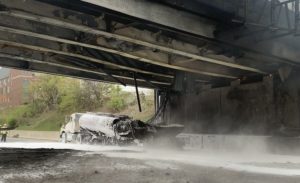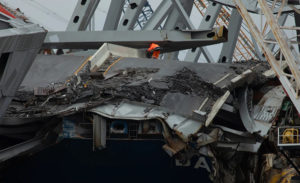
Type II helmets like the Studson models have padding and shock-absorbing technology to protect against side, back and front impacts from slips and falls.
Photo courtesy Cam McLeod/Studson
In December, the U.S. Department of Labor’s Occupational Safety and Health Administration announced it was replacing traditional hardhats for its employees with ANSI-Z89.1-certified Type II safety helmets when they work on sites. But some contractors had been requiring the more protective helmets for at least some of their workers since 2015.
Type II helmets protect against side, back and even some frontal impacts, while traditional hardhat technology, which dates back in its current form to at least 1919, is only designed to protect the wearer from impacts from above. To qualify under the ANSI standard, Type II helmets have to have some form of anti-concussion technology to protect against traumatic brain injuries. While no helmet technology can prevent all concussions or brain injuries, the technologies being referred to are all designed to absorb shock, reduce rotational force in a fall and protect their users heads as much as possible. All of the contractors in this story required a chinstrap to be used to keep the helmet on worker's heads in a slip and fall incident (the ANSI standard, itself, does not require chinstraps). Before requiring its own inspectors to use Type II helmets, OSHA published a Safety and Health Information Bulletin Nov. 22, 2023 detailing key differences between the two types.
According to the Centers for Disease Control and Prevention, the construction industry has the greatest number of both fatal and nonfatal work-related traumatic brain injuries in U.S. workplaces. From 2003 to 2010, 2,210 construction workers died because of a TBI (a rate of 2.6 per 100,000 full time equivalent workers). These deaths represented 25% of all construction fatalities and 24% of all work-related fatalities among all industries during that period.
In its Dec. 11 message outlining its staff policy, OSHA recommended Type II safety helmets be used by people working in construction, oil and gas; in high-temperature, specialized work and low-risk environments; performing tasks involving electrical work and working from heights. But some in the industry are already ahead of the curve.

The Kask models also feature anti-concussion technology, padding, crumple areas and optional integrated eye protection.
Photo courtesy Gilbane Building Co.
“We started looking into how we’d do this in 2015,” says Seth Randall, regional safety director at Clark Construction. “In 2016, Clark Concrete was one of our self-perform divisions where every carpenter, laborer, cement mason all went to Kask.” The initiative quickly spread. “Six months later, as a company we strategically began to roll them out, and by 2017 every Clark employee was all-in on helmets.”
Clark went with a Type 1 helmet meeting the performance requirements of European standard EN-12492 (see below).
Other contractors interviewed for this story that got out ahead of OSHA and required Type II helmets on site include Clayco, Pepper Construction, the Boldt Co., Gilbane Building Cos. and specialty contractor Limbach Co. Boldt began a rollout of Type II helmets for all of its personnel in 2018. Gilbane started introducing the helmets to its employees in 2016 and brought them to all of its divisions by 2018. In 2022, Gilbane set a requirement for all trade contractors working on the firm’s jobsites. Clark requires all subcontractors on its sites to use a list of approved helmets, and Boldt will begin enforcing a similar rule in July.
All of the contractors ENR spoke with say sharing information via Construction Safety Week events, industry organizations such as the National Academy of Construction and among trade and labor partners has helped them along their journey to safer helmets.
The process wasn’t always smooth. There was conflicting information in the marketplace. The culture of jobsites and construction had to be approached properly by safety managers. “In construction, it’s one of those little quirky things, your hardhat,” explained Brian Biggers, a Clayco senior superintendent from Charlotte, N.C. “That hardhat means a lot: That is who you are, the stickers on it show where you have been, and they are badges of honor. They show the jobs you worked on, and the more stickers, the more respect.”
Biggers was an eyewitness earlier in his career to a fall incident where a hardhat came off of a coworker’s head, resulting in a much more serious injury.
“A guy hit his head and his hardhat had flown off in the fall,” he says. “I was 20 years old at the time. That kind of thing sticks in your mind. I remember that day like it was yesterday. I remember seeing this guy laying on the stones that he had fallen on, with his head about twice the size of a normal human head. When I saw this new type of hardhat, I thought if that guy had that on that would have at least helped protect his head.”

A Clark assistant superintendent distributes a Type II safety helmet with a chinstrap to a craftworker during Safety Week 2022.
Photo courtesy of Clark Construction
Hardhats vs Helmets
While the technology behind hardhats has developed during more than 100 years of hardhat use in the industry, Type II helmet technology and the impetus for bringing it to an ANSI standard came from a European mountaineering standard: EN-12492. Gilbane has written aspects of both it and ANSI Z89.1 into its policy requiring Type II helmets. Many of the anti-concussion and shock-absorption technologies that go into the helmets come from the world of sports such as rock climbing, bicycling and even professional football. Helmets using rotational impact reduction systems such as Koroyd, the multidirectional impact protection system (MIPS) and Brainshield have shown considerable promise in multiple, competing studies. While some construction hardhats cost as little as $50, the average cost of a Type II helmet is closer to $150. Hardhats can be made of relatively cheap plastic while some Type II helmets are made of more expensive materials such as carbon fiber.
“When our executive team discussed the transition, we had not had a traumatic brain injury ever on our sites. We still have not had a TBI at Boldt, and we want to make sure it stays that way. Cost really wasn’t an issue,” says Scott Frazer, vice president of corporate safety at Boldt, who echoed a sentiment from other contractors that require Type II helmets. But there are still issues to sort out between contractors and manufacturers.

Wavecel’s type II safety helmets all ship with chinstraps, but the rachet-turn tightening system is still included with some of their full-brim models.
“One thing about the change from hardhats to Type II helmets for hot work, our field personnel would have to take their gloves off to adjust the chinstrap,” says Kristin Clements, safety operations manager at Boldt. “We talked with the manufacturers about how you can’t take them off without creating another risk, and they responded.” Jackson Safety now has a push button where the wearer can adjust the chinstrap with gloves on.
Studson, which started operations in 2019, has a magnetic connector on its chinstraps that allows manipulation with gloves on. When it delivered its first helmets to contractor customers in 2021, Studson joined a crowded field of Type II helmet manufacturers that already included Wavecel, Kask, Milwaukee Tool, Jackson and others. “Most of these chinstraps we’re using are all very high-quality textiles, they’ve got lots of adjustability, “ says Ryan Barnes, Studson CEO. “You can get it right where you want it, but you do have to take a few minutes to adjust it so you can get it set right.”
Field Research and Development
Like Wavecel before it, Studson put out a line of full-brim Type II helmets with Koroyd anti-concussion technology to try to gain more traction in the U.S. construction market while also embracing new technologies such as TwiceMe, an app that stores a user’s medical information in a chip in the helmet. First responders with the proper tools can access the app securely and retrieve information such as the wearer’s blood type or if they are a recovering addict and do not want to be given opioids as a part of first-aid treatment. The information can be provided to first responders as a text message as well as in the app and the most common information users include are blood type, diabetes status, allergies, and other pertinent medical information and emergency contacts. Studson closed a $2.48-million funding round March 14 and announced a strategic partnership with Blaklader, one of Europe’s largest producers of workwear. Clayco and Pepper selected Studson as their helmet supplier in 2023.
“We started on this project way back in 2017; we actually had a couple of design schools like Savannah College of Art and Design looking into what the hardhat of the future would really look like,” says Bob Clark, Clayco co-founder and executive chairman. “We wanted it all, we wanted ventilation, we wanted chinstraps and a lot of companies were simply adapting rock climbing and biking helmets. Even Studson, we thought in the beginning, was doing that.” Clark says Studson responded well to the designs Clayco submitted and started applying the features to its own helmets. “We ended up with a helmet that looks like a construction tool,” Clark says.
Jordan Peters, Clayco’s regional safety manager in St. Louis, says the company tested out eight or nine styles from different manufacturers, and Kask performed well in those tests. “It was pretty much neck-and-neck with Studson and Kask on the comfortability factor, and the technology that it offers, but at the same time, Studson was more willing, I believe, to work with us in creating the full brim,” Peters says.

Studson’s full-brim, vented Type II helmet comes with a TwiceMe chip that allows first responders to access medical information the wearer has voluntarily entered in the related app.
Peters says that requiring helmets before OSHA did for its own personnel or being out ahead of other contractors isn’t what motivated Clayco’s research into and eventual move to Type II helmets.
“It really starts at the top with Bob Clark. He prides himself on doing what’s best for his employees. I think that would be the point of pride,” he says. “[It] is not so much [about] beating OSHA, but doing everything that we can to protect the workforce.”
Pepper, another company that went with Studson as its supplier, cited the helmet’s appearance as a factor. “We started looking at it three years ago,” says Daniel Ruane, vice president of safety at Pepper Construction. “A lot of pushback from people in the field was just because of the looks. They did not like the bike helmet style.”
Ruane says Pepper started considering a shift to Type II helmets in 2018 and standardized its workforce on Studson helmets in 2023. About 95% of the firm’s workers have Type II helmets now, and Ruane says they are fielding questions about their rollout from other general contractors in the Midwest, as well as their own subcontractors.
“We’re leading by example and I do think in the next two to three years we’re not going to have to require it for subs or anyone else—it’s just going to be more of the norm in construction,” says Ruane.
Wavecel also produces full-brim Type II helmets that use their own proprietary anti-concussion technology but still retain some of the form factor seen in construction head protection.
“There is tradition, there is heritage, and it’s meaningful,” says David Visnack, chief marketing officer at Wavecel. “What we looked at was modern design to build the safest helmet possible that honors that look and feel, that tradition.”
All of the contractors mentioned that ENR spoke to were working with manufacturers on optimizing their Type II helmets. But the National Academy of Construction, the Construction Industry Roundtable and other industry groups are also talking to regulators about what they’ve learned in the field.

Clayco tested several Type II helmets from 2017 to 2020 before settling on Studson’s full-brim, ventilated, Koroyd-enabled version. The helmets also come equipped with the TwiceMe chip.
Photos courtesy Clayco
“The movement from hardhats to helmets has taken engineering and it’s taken study but we, quite frankly, don’t understand why it hadn’t been adopted by all at this point,” says Tom Gilbane Jr., chairman and CEO, Gilbane Building Co.
For specialty contractors, the challenge in making a full switch to Type II involves other concerns, such as working in tight spaces while installing mechanical equipment, welding-related eye protection and heat issues.
But specialty firms can influence project owners better when they work directly for them.“In some of our work we work directly for building owners; some of the work we do through general contractors,” says Mike McCann, president and CEO of Limbach. “We’ve really empowered our teams, regardless of what’s going on otherwise, into wearing [the helmets], and being positive about influencing people outside of our company. We want to set that example.”
Clark requires subs on its sites to use Type II helmets, and is working with its helmet supplier to help newcomers along. The firm has a list of approved Type II helmets and says it’s growing as new technologies enters the market.
“Kask has been great with continuing to innovate and creating new helmets, many different standards, and keep on pushing that limit,” Clark’s Randall says. “We have a good working relationship on that, as for other subcontractors on projects, we’re not going to really tell them what to wear. We believe our policy kind of tells them what head protection standard we expect them to meet. It’s up to them to kind of do their homework.”
Retired Limbach Chairman and CEO Charlie Bacon was active in both CIRT and NAC and—in his capacity promoting safety industry-wide—met with then-mayor of Boston, Marty Walsh, in 2013. The two struck up a working relationship around construction safety initiatives as Walsh himself had worked as a construction laborer and had been a member of Laborers International before he began his political career. When Walsh became secretary of labor in the Biden administration in 2021, Bacon met with him as a NAC leader to discuss the ACE Mentor Program. He noticed a hardhat on Walsh’s desk and asked about it. Bacon took note of the many stickers that reflected so much about where its owner had worked in the past, and heard a personal story about what that hardhat meant to Walsh.
“It had stickers on it, all of the old Boston companies were on it. I said, ‘I like that helmet on your desk,” Bacon recalls. “He said, ‘that’s my grandfather’s.’ I said to him, ‘you know, Secretary Walsh, back then that was that was high tech, this is high tech now,’” and showed him one of the newer Type II helmets. Bacon can’t be sure if this spurred the OSHA policy shift, but he’s proud that the industry was taking the initiative.
“It has to be part of our routine,” notes Gilbane. “Are our chinstraps buckled? Are our gloves on? Is our eye protection on? Are we doing things unsafely anywhere? We can perform the work safely on all our sites.”










Post a comment to this article
Report Abusive Comment